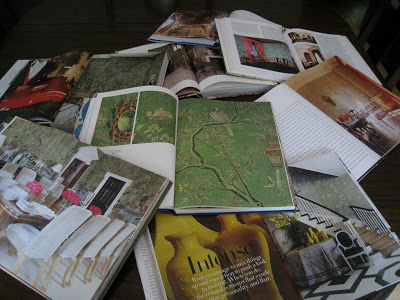My friend Mrs. Grizwald mentioned once, “It’s funny how there are billions of the people in the world and only 365 days in a year, yet we are always delighted and amazed when we find out we share a birthday with someone.” It’s true. I recently discovered, while thumbing The Secret Language of Birthdays yet again, that I share a birthday with Myrna Loy. I’ve probably mentioned it to a dozen people since then.
As a great over-thinker, birthdays offer me the guilty pleasure of self-indulgent self-reflection. It’s not just the heat of August that makes me quiet and pensive, but the recognition that my year is about to begin again. I rarely run willy-nilly, but rather pick a careful path and to do so, every now and then, I have to survey the terrain. The funny thing is, the most significant insights seem to find me. It’s remarkable with the amount of information and observation that bombards me daily, that there are some things that hit at just the right time. That stick.
This year, about the time I started to be still and take stock, two men, writers both, stopped in to remark on aging. The first was F. Scott Fitzgerald. In a review of his essays, The Wall Street Journal noted Fitzgerald as saying that old people were incapable of self-improvement, “Almost barbarians.” And by old he meant thirty.
The next was David Foster Wallace in his collection of essays, A Supposedly Fun Thing I’ll Never Do Again, “I’m starting to see how as time gains momentum my choices will narrow and their foreclosures multiply exponentially until I arrive at some point on some branch of all life’s sumptuous branching complexity at which I am finally locked in and stuck on one path and time speeds me through stages of stasis and atrophy and decay until I go down for the third time, all struggle for naught, drowned by time. It is dreadful. But since it’s my own choices that’ll lock me in, it seems unavoidable – if I want to be any kind of grownup, I have to make choices and regret foreclosures and try to live with them.”
Also in the Journal (the Journal offering some sticky stuff that week) was a review of Kurt Vonnegut’s Novels & Stories, 1963 – 1973. It was noted that in response to the question, “When may we expect your next novel?” following the release of Slaughterhouse Five, Vonnegut reported thinking, “Next novel? That was it. That was my novel.” This notion was very sticky.
About this time, I finished Jonathan Franzen’s second novel, Strong Motion. Franzen is one of my favorite contemporary writers. Strong Motion was like looking through a box of your college boyfriend’s childhood pictures. I recognized him, though he was not so lean. But I didn’t like the book and I couldn’t care for the characters and I know more about seismology than I ever wanted to. I’ve past feeling the need to finish an unenjoyed book, but I needed to know Franzen better. I took the book by spoonfuls and about three-quarters of the way through I realized that what it was showing me, the stickiness of it, was that writers mature.
There are books that I keep holding up to myself as the excuse to not begin, but they are not the beginnings. Like all other things, writing takes practice. At a book signing here in Kansas City someone asked Franzen about his process, and he said, spinning his arm like he was hitting the final chords in an air guitar solo, you just have to keep churning and churning until there is something.
I am insecure, anxious and dismissive of my writing. A middling talent. Something that could have been something, but will not; I’ve started too late. And, if I have a story to tell, I feel that it is one story, only mine, and if that is all there is to offer then it’s not really a talent. It’s dictation.
Still, I am writing in my head all the time. Turning the words for blog post or article or some other as yet undiscovered thing. It tumbles and tumbles and tumbles and then it sort of throws itself out onto the page. I don’t know how to begin if it is not finished yet.
But I believe that American lives can have second acts. Creativity and complexity do not end in one’s thirties. And even though I may be in a sort of active intermission, a vivacious mingling in the lobby rather than a full-on second act, I think it may be richer than if the same sort of momentum had converged for me at twenty-six. Middle age does not encompass only atrophy, decay and regret even among grown-ups.
So I’ve decided to ignore these words of Fitzgerald and Wallace and follow instead the implied message of Vonnegut, whom I care for least of the three. I’m 46 today. I’ve been writing Mrs. Blandings for four years. The exercise of sitting down and writing this blog every day has been remarkable. I don’t intend to quit blogging, but I need to try to write some other things. Some longer things. I’m not quite sure how that will affect what happens here, but I didn’t want you to think I’m losing interest. I’d just like to write something that takes longer to read than a minute-and-a-half .
In addition, I need to get my house in order. Literally. The moving out and the moving in to the house with no name has left everything in a jumble. I am taking a little time off. A week. Maybe two. But I will re-post some of my favorites here just in case you stop by.
You will never know how grateful and flattered I am that you make Mrs. Blandings part of your day.









